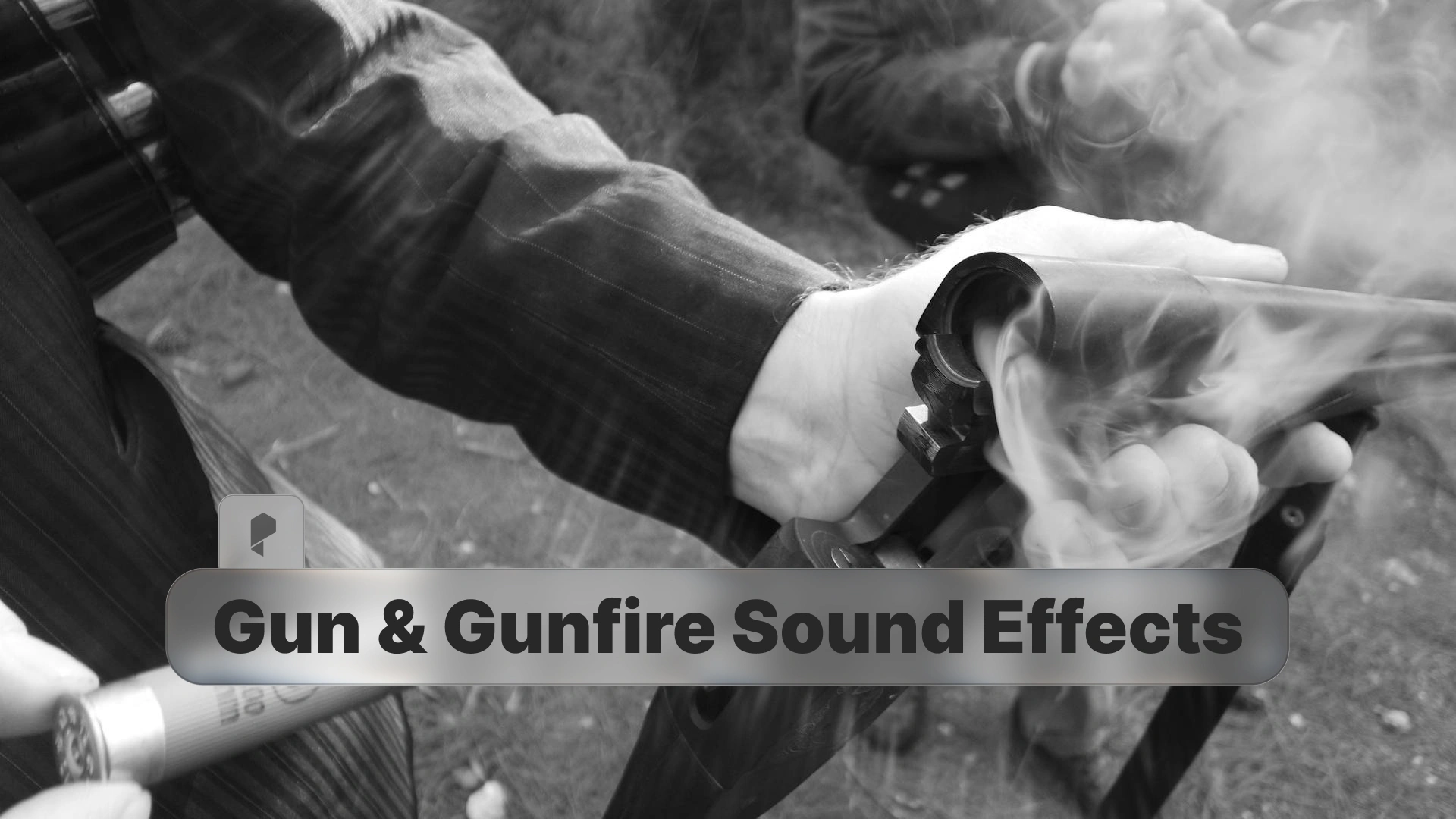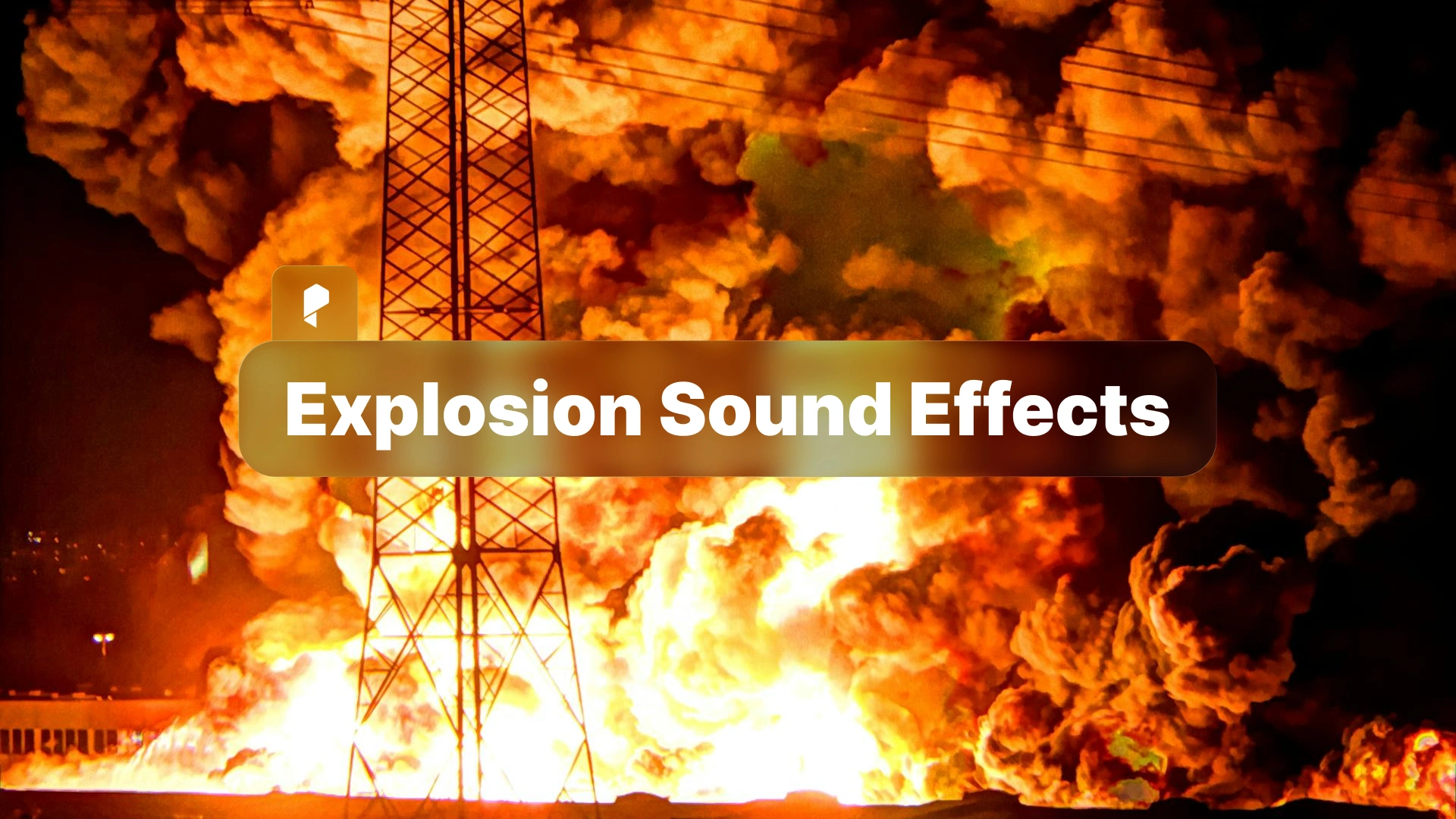Breaking Glass & Metal Impact Sound Effects for Destruction Scenes

- Understanding Material Destruction Sounds
- Understanding Glass Sound Effects
- Types of Glass Breaking Sounds
- Understanding Metal Impact Sounds
- Types of Metal Impact Sound Effects
- Creating Realistic Glass Audio
- Creating Realistic Metal Audio
- Using Glass Effects in Different Scenes
- Using Metal Effects in Different Scenes
- Layering Glass and Metal for Complex Destruction
This guide walks you through everything you need to know about glass and metal impact sound effects: understanding the physics behind these sounds, selecting the right types for different scenarios, layering techniques for maximum realism, and how to implement them effectively in your video projects.
Understanding Material Destruction Sounds
The physics of breaking materials directly influences how we hear them. When glass shatters, it releases energy at multiple frequencies simultaneously, creating that characteristic sharp, bright sound. Metal impacts, on the other hand, cause the entire object to vibrate, producing complex harmonic overtones that ring out over time.
Material-specific sounds matter because audiences have learned to associate specific sonic characteristics with specific materials. When sound doesn’t match the visual, it creates cognitive dissonance that breaks immersion. A car windshield that sounds like wood breaking, or a steel beam that sounds like plastic, immediately signals “fake” to viewers.
In destruction sound design, authenticity comes from understanding three key elements: the initial impact or break, the scatter or resonance phase, and the environmental context. Each element contributes to the overall believability of the effect.
Understanding Glass Sound Effects
The shatter and scatter phase is where most of the sonic complexity happens. As glass breaks into hundreds or thousands of pieces, each fragment produces its own sound. Larger pieces create lower frequencies, while tiny shards produce bright, tinkling highs. This creates a rich, dense soundscape that evolves over several seconds.
The final phase is when pieces hit the ground and settle. This produces secondary impacts, rolls, and slides that extend the sonic event. Small glass particles create delicate, sparkling sounds, while larger chunks produce heavier thuds mixed with additional shattering.
Different types of glass produce distinctly different sounds based on thickness, temper, and composition. Window glass is relatively thin and produces bright, high-frequency shatters. Tempered glass (like car windows) creates more uniform, pellet-like sounds. Bottles have resonance chambers that add tonal qualities before they break.
Professional Glass Sound Effects








Types of Glass Breaking Sounds
Window Shattering
Window glass breaking is one of the most common glass effects in action films. Standard window glass produces a sharp initial crack followed by large, irregular shards falling. The sound is bright and cutting, with prominent high frequencies. Double-pane windows add complexity with two separate break events in quick succession.
For realistic window shatters, you’ll need a premium sound effects library that captures the full frequency range and natural timing of real glass breaking.
Bottle Breaking
Bottle breaks have a distinct tonal quality before the shatter. The air cavity inside the bottle creates resonance at specific frequencies, giving bottles a characteristic “ring” before they break. The glass is typically thicker than window glass, so the break has more low-mid frequency content. Beer bottles, wine bottles, and glass containers each have slightly different sonic profiles.
Car Windshield
Automotive glass is specially tempered for safety, creating a unique sound signature. When a windshield breaks, it produces thousands of small, uniform pieces rather than large shards. This creates a denser, more granular sound with less variation in pitch. The laminate layer in windshields also dampens the sound somewhat, making it less bright than regular window glass.
Large Glass Panels
Storefront windows, glass doors, and architectural glass panels produce massive, dramatic breaks. The large surface area means more glass is breaking simultaneously, creating a louder, denser sound with longer decay. These breaks often include the sound of the frame distorting and metal fixtures breaking alongside the glass.
Small Glass Objects
Drinking glasses, picture frames, and small glass items produce more focused, compact breaking sounds. There’s less scatter and shorter decay times. The initial break is prominent, but the overall event is briefer and less complex than larger glass objects.
Understanding Metal Impact Sounds
Material characteristics significantly affect the sound. Steel produces bright, aggressive impacts with long sustain. Iron has a darker, heavier quality. Aluminum is lighter and produces higher-pitched impacts with faster decay. Copper and brass have warmer, more musical tones.
Impact versus crash sounds represent different types of metal collision events. An impact is typically a single, focused strike with clear attack and ring-out. A crash involves multiple pieces of metal hitting simultaneously or in quick succession, creating a more chaotic, dense sound with overlapping resonances.
Metal types and tones vary widely across the spectrum. Heavy structural steel produces deep, powerful impacts in the 80-400 Hz range. Sheet metal produces thinner, rattling sounds with prominent high-frequency content. Hollow metal objects like pipes add resonance chambers that emphasize specific frequencies.
Professional Metal Sound Effects








Types of Metal Impact Sound Effects
Heavy Metal Impacts
Heavy metal impacts are the foundation of industrial and large-scale destruction scenes. These sounds feature powerful low-frequency content, aggressive midrange attack, and long, complex decay tails. Think of wrecking balls hitting steel beams, massive machinery colliding, or structural metal being crushed. These impacts need substantial bass frequencies to convey weight and power.
Metal Pipe Sounds
Metal pipes are incredibly versatile in sound design. Hollow pipes create distinctive resonance when struck, with a clear fundamental frequency and overtones. The length and diameter of the pipe determine the pitch and character. Short, wide pipes produce lower, more aggressive sounds, while long, thin pipes create higher, more musical tones. Pipe impacts, rolls, and drops each produce unique sonic characteristics.
Steel Crashes
Steel crashes involve multiple pieces of steel impacting simultaneously. This could be steel drums falling, metal scaffolding collapsing, or steel beams hitting each other. The sound is dense and chaotic, with overlapping frequencies creating a wall of metallic noise. Steel crashes have substantial energy across the entire frequency spectrum, from deep lows to cutting highs.
Industrial Metal
Industrial metal sounds encompass factory equipment, machinery impacts, and mechanical collisions. These sounds often combine metal impacts with additional mechanical elements like gears, chains, and hydraulics. Industrial metal tends to be darker and more aggressive than clean metal impacts, with distortion and complexity from real-world industrial environments.
Metal Clang and Ring
Metal clangs emphasize the resonant “ring” after impact. These sounds feature clear harmonic content, musical overtones, and extended decay. Bells, steel rods, and metal tools produce excellent clang sounds. The ring can last several seconds, creating a distinctive sonic signature that’s immediately recognizable as metal.
Creating Realistic Glass Audio
The shatter layer comes immediately after the break. This is where you add the dense cascade of glass fragments. Use sounds with complex high-frequency content that evolve over time. For larger glass objects, layer multiple shatter sounds slightly offset to create density and scale. Small timing variations between layers make the overall effect sound more natural.
The scatter and tinkle phase needs detailed, delicate sounds. Add layers of small glass pieces hitting surfaces, rolling, and settling. These quieter elements extend the sonic event and add realism. Don’t underestimate these details, they sell the believability of the effect.
Environmental factors dramatically affect glass sounds. A glass breaking in a small room produces more reverb and reflection than glass breaking outdoors. Add subtle room tone and reverb that matches your visual environment. Consider what surface the glass is falling onto, concrete, wood, carpet, and tile all produce different secondary impact sounds.
Distance and space require careful frequency management. Close-up glass breaks have full frequency content with prominent highs. As distance increases, high frequencies attenuate first. Distant glass breaks sound darker and less detailed, with more environmental reflection and less direct sound. Use EQ and reverb to position your glass sounds correctly in the sonic space.
Professional Shatter Sound Effects








Creating Realistic Metal Audio
The resonance layer is crucial for metal authenticity. After the initial impact, metal vibrates and rings. This resonance should match the size and type of metal in your scene. Large metal objects produce lower resonance frequencies with longer decay times. Small metal objects ring at higher frequencies and decay more quickly. Layer multiple resonance sounds with slightly different pitches to create harmonic complexity.
Adding metallic ring and overtones creates depth and character. Real metal impacts produce complex harmonic series, the fundamental frequency plus integer multiples (overtones). Using multiple layered sounds with related pitches creates this harmonic richness. You can also use pitch-shifting and frequency modulation to generate synthetic overtones that complement your base sounds.
Environmental factors affect metal sounds just like glass. Hard surfaces like concrete produce bright reflections, while soft surfaces like earth absorb high frequencies. Indoor environments add reverb and multiple reflections. A high-quality collection of metal and glass sound effects makes it easier to find source material with appropriate environmental characteristics.
Distance and space management for metal follows similar principles to glass, but with different frequency curves. Metal impacts maintain more low and mid-frequency content at distance than glass does. The ring and resonance can actually become more prominent at medium distances as the sharp attack transient softens. Use multi-band EQ to shape the frequency response based on distance, and add environmental reverb to place the sound in space.
Using Glass Effects in Different Scenes
Action Sequences
In action sequences, glass breaking adds visceral impact to fights, chases, and explosions. Timing is critical, the glass break should sync precisely with the visual impact. For hand-to-hand combat scenes, use moderate-sized glass breaks with quick attack and relatively short decay. In gunfight scenes, use sharper, more explosive glass sounds that emphasize the violence of bullets passing through windows.
Horror and Suspense
Horror films use glass sound effects to create tension and jump scares. The sharp, unexpected nature of breaking glass triggers a primal fear response. In suspense sequences, even small glass sounds like a cracking window or a glass tipping over can build unease. Layer glass sounds with unsettling ambiences and low-frequency rumbles to enhance psychological impact.
Car Crashes
Automotive crashes require multiple glass elements. Windshields, side windows, and rear windows all break with different characteristics. Tempered safety glass produces that distinctive granular sound. Layer multiple glass breaks to represent different windows breaking at different moments during the crash. Add glass falling into the car interior for additional detail.
Bar Fights
Bar fight scenes traditionally feature lots of glass, bottles breaking, mirrors shattering, glasses smashing. Each element needs proper differentiation. Bottles have pre-break resonance and thicker glass sounds. Mirrors break like large, thin glass panels. Drinking glasses produce compact, focused breaks. Vary the sounds to keep each impact distinct and interesting.
Urban Destruction
Large-scale urban destruction scenes require massive glass effects. Entire building facades of glass exploding outward, storefronts shattering, and skyscraper windows bursting create spectacular sonic moments. Use heavily layered glass sounds with long, complex decays. Add environmental reverb to place the sounds in a large urban space. Consider adding distant glass sounds to suggest destruction happening beyond the immediate visible area.
Professional Cinematic Sound Effects







Using Metal Effects in Different Scenes
Industrial Settings
Industrial environments are naturally rich with metal sounds. Factory scenes benefit from constant ambient metal impacts, machinery noise, and equipment operation. Use varied metal sounds to create a realistic industrial soundscape. Heavy metal impacts for large equipment, metal clangs for tools and parts, and steel crashes for accidents or malfunctions all contribute to authenticity.
Combat Scenes
Metal impacts are essential in combat sequences involving weapons, armor, or vehicles. Sword fights feature blade impacts with sharp attack and bright ring. Medieval armor produces hollow metal clangs when struck. Modern combat scenes use metal impacts for bullets hitting vehicles, equipment being destroyed, and weaponry operation. Each impact should feel weighty and consequential.
Car Crashes
Vehicle collisions produce extensive metal destruction sounds. The initial impact creates a massive metal crash as body panels collide and crumple. This is followed by ongoing metal distortion sounds as the vehicles continue to deform. Add specific elements like metal scraping, parts breaking off, and structural metal failing. Heavy metal impacts represent major structural damage, while lighter metal sounds suggest cosmetic damage.
Robot and Mech Sounds
Mechanical characters and giant robots require carefully designed metal sound palettes. Every movement should incorporate metal servos, hydraulics, and structural creaking. Combat sequences feature heavy metal impacts as mechanical limbs strike each other. Use industrial metal sounds for mechanical transformation sequences. Layer multiple metal elements to create unique sonic identities for different mechanical characters. Finding the right sounds is easier with a comprehensive sound effects library designed for video production.
Construction Scenes
Construction environments provide opportunities for diverse metal sounds. Steel beams being placed produce heavy metal impacts. Rebar being cut creates sharp metal stress sounds. Equipment operation features ongoing metal mechanical sounds. Metal tools dropping, scaffolding assembly, and structural work all contribute to an authentic construction soundscape.
Layering Glass and Metal for Complex Destruction
Combining materials requires attention to timing and frequency balance. Start with the heaviest, most impactful elements, typically the metal impacts. These provide the foundational low-frequency energy and define the overall scale of destruction. Layer glass sounds on top, occupying the mid and high-frequency ranges. The glass adds detail and complexity without competing for sonic space.
Creating believable crashes means thinking about the sequence of destruction. What breaks first? In a car crash, initial metal impact happens first, followed almost immediately by glass beginning to shatter, then ongoing metal deformation. In a building collapse, structural metal fails first with deep groans and impacts, then glass explodes outward slightly later as the structure deforms.
Multi-material destruction scenes benefit from careful panning and spatial placement. Don’t put all sounds in the center. Spread different elements across the stereo field to create width and realism. Glass falling to the left, metal crashing to the right, with the main impact in the center creates an immersive soundscape. Use reverb and delay to place elements at different depths in the mix.
The key to complex destruction is variation and evolution. The sound should change and develop over time rather than being a single static crash. Layer sounds with different timing, different characteristics, and different spatial positions. This creates the complexity and chaos that makes destruction feel real and impactful.
Related Destruction Sound Effects
Glass and metal are just part of a complete destruction sound design toolkit. For comprehensive destruction sequences, you’ll also need Explosion and blast sound effects to add explosive force and sword and blade sound effects for combat sequences.
For broader context on action sound design, explore the Cinematic & Action Sound Effects guide to see how these material-specific sounds fit into your overall audio strategy.
Conclusion
Success with material destruction sounds comes from three key practices: choosing sounds that match the specific material type and scale, layering multiple elements to create density and realism, and carefully managing timing and frequency balance so each element enhances rather than competes with others.
Ready to elevate your destruction sound design? Explore professional glass and metal sound effects crafted specifically for video editors and motion designers working on high-impact action content.





